In today’s digital-centric landscape, popups serve as a critical tool for engaging website visitors, capturing leads, and converting them into customers.
However, the effectiveness of a popup can vary significantly based on its design, content, and placement.
This is where A/B testing comes in, which allows marketers to compare two versions of a popup to determine which one performs better in terms of user engagement and conversion rates.
By testing variations against one another, businesses can uncover data-driven insights that optimize the user experience.
This blog will explore all the nuances of A/B testing for popups, offering practical examples and best practices to enhance your digital marketing strategy.
But before that, if you would like to know how to create popups with ease, here is a simple video for you:
Planning Your A/B Tests
The foundation of any successful A/B testing campaign, especially for website popups, lies in meticulous planning.
This stage is crucial for defining clear objectives, setting measurable goals, and identifying the key elements you wish to test. Whether it’s the popup’s headline, call-to-action (CTA), imagery, or the timing of its appearance, understanding what impacts user behavior is essential. Planning also involves segmenting your audience to ensure that the test results are as relevant as possible.
Additionally, determining the duration of your test and the statistical significance needed for reliable results is vital.
By carefully planning your A/B tests, you can ensure that your efforts are not only methodical but also aligned with your overall marketing goals, leading to more effective and engaging popups.
5 Ideas on What to A/B Test
These enriched ideas offer a deeper insight into the nuanced strategies and outcomes of A/B testing for popups. Let’s take a look at them:
1. Exit-Intent Popups
Optimizing exit-intent popups through A/B testing is crucial for capturing users’ attention just as they’re about to leave your site.
By experimenting with different offers, messaging styles, and design aesthetics—from offering discount codes vs. exclusive content and using urgent vs. informative messaging to testing minimalist vs. vibrant designs—you can identify what best resonates with your audience.
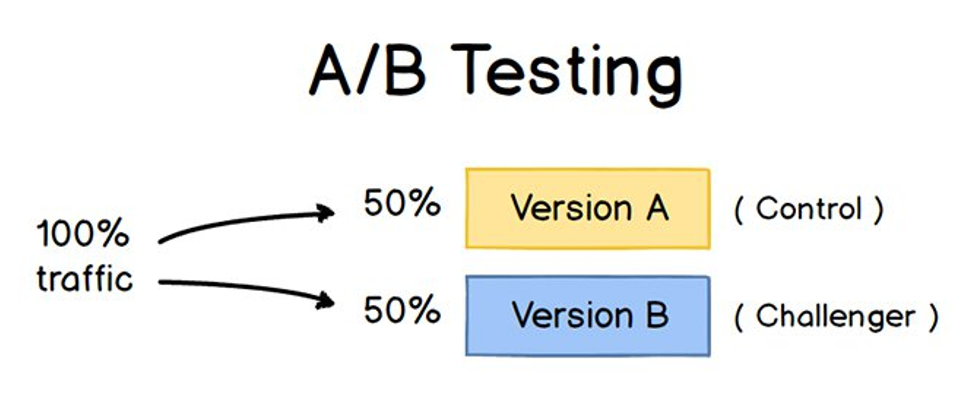
Incorporating a popup builder tool with built-in A/B testing capabilities streamlines this process, allowing you to test and compare variations effortlessly. Such tools automatically present different popup versions to various audience segments, directly measuring effectiveness in engaging users and preventing site exits.
This not only saves valuable time but also delivers actionable insights, enabling the creation of highly optimized exit-intent popups that effectively lower bounce rates and boost conversion opportunities.
2. Call-to-Action
The call-to-action (CTA) button stands at the heart of any campaign or landing page, playing a pivotal role in motivating users to take your desired action.
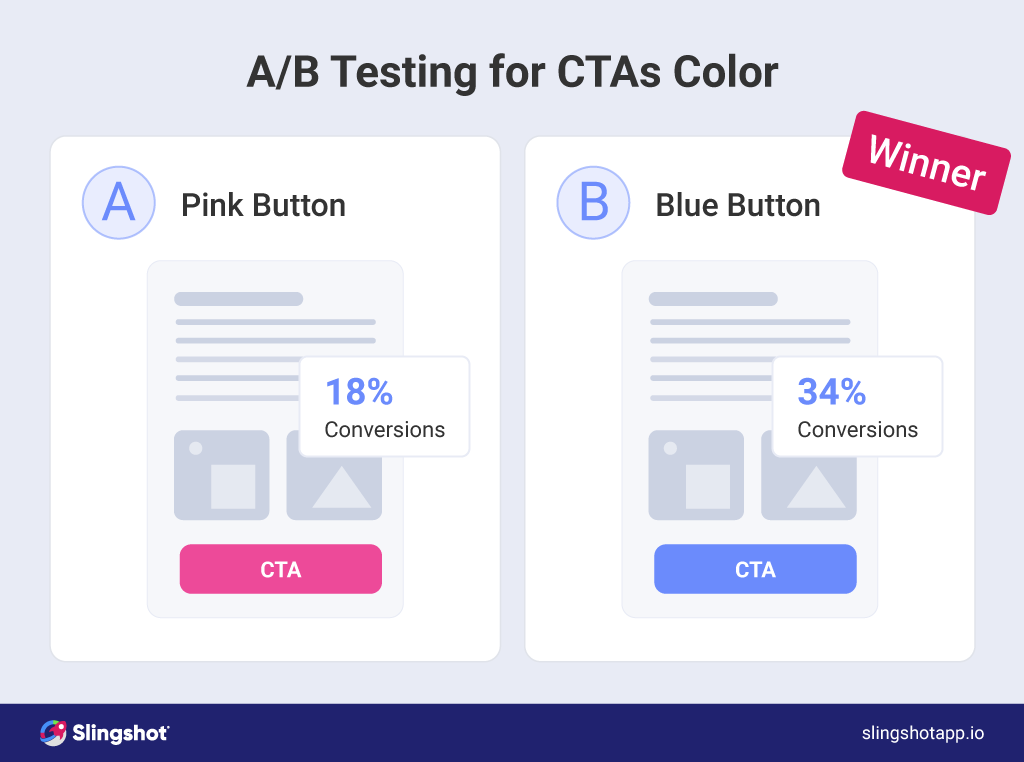
To maximize conversion rates, conducting split tests on various CTA elements is crucial. This includes exploring variations in the CTA’s text, button size, color, placement, and even the choice between a button and a hyperlink. Incorporating emojis in the CTA button is another tactic that could enhance engagement.
Each modification to the CTA has the potential to impact conversion rates significantly. Additionally, tailoring your CTA testing for mobile users is advisable, ensuring that the mobile experience is optimized for engagement and conversion.
3. Engagement Timers
The timing of a popup’s appearance can drastically influence its success.
A/B testing engagement timers involves experimenting with different intervals, such as displaying a recommendation popup immediately after a user lands on the page versus after they’ve engaged with content for a predefined period. This strategy helps identify the “golden moment” for popup engagement, where the likelihood of positive user interaction is highest.
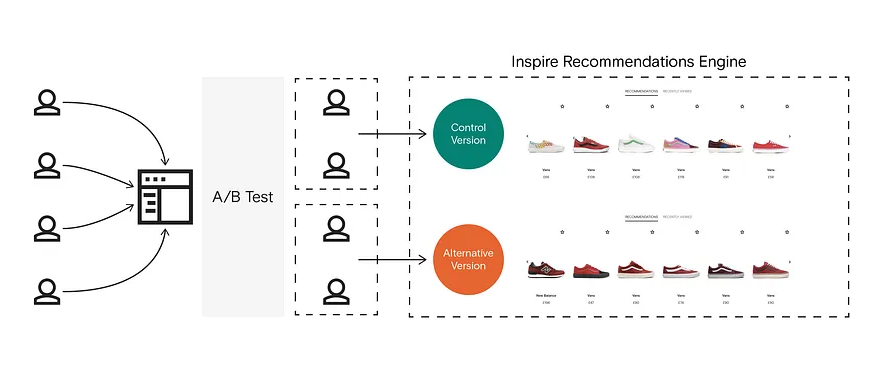
Finding this balance is key to improving user experience by ensuring popups appear when users are most receptive, thereby increasing the likelihood of achieving your popup’s goals, whether that’s gathering email sign-ups or promoting specific content.
4. Mobile vs. Desktop Popups
Given the differing user experiences on mobile and desktop devices, it’s crucial to optimize popups for each.
A/B testing can explore variations in design (full-screen overlays on desktop vs. subtler slide-ins on mobile), functionality (dismissibility), and content layout (simplified for mobile) to determine what resonates best on each platform.
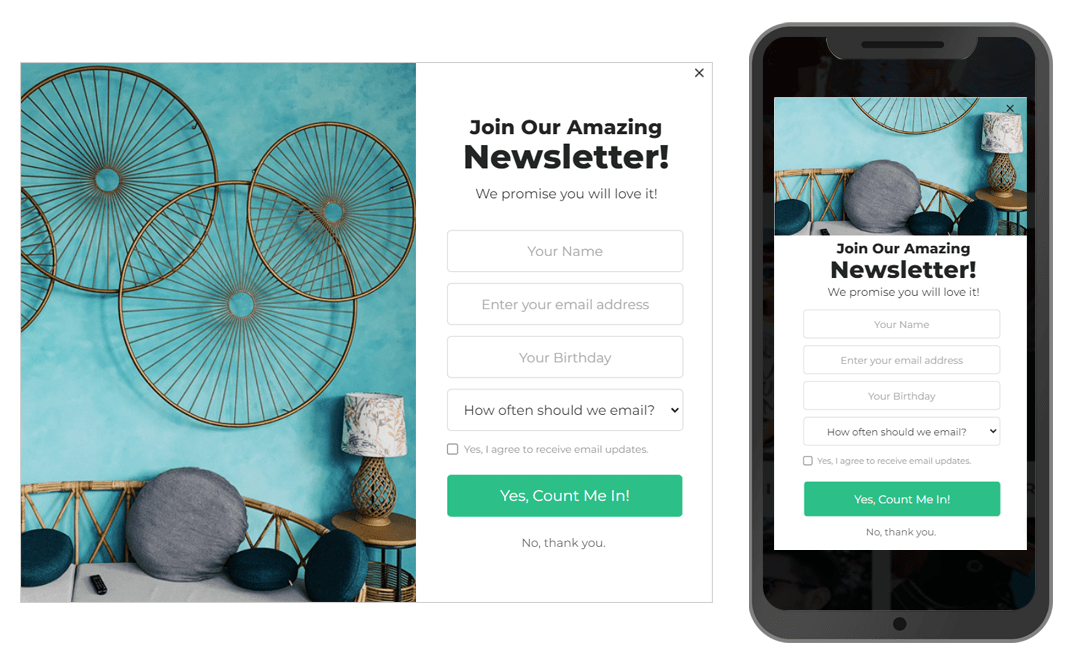
This tailored approach ensures that popups enhance, rather than detract from, the user experience on every device, maximizing engagement and conversion rates by catering to the unique navigation patterns and preferences of mobile and desktop users alike.
5. Segmentation Tests
Personalization can significantly increase the effectiveness of popups. By A/B testing popups tailored to different audience segments (e.g., new visitors, returning customers, or users who’ve abandoned their cart), you can determine how well each version performs.
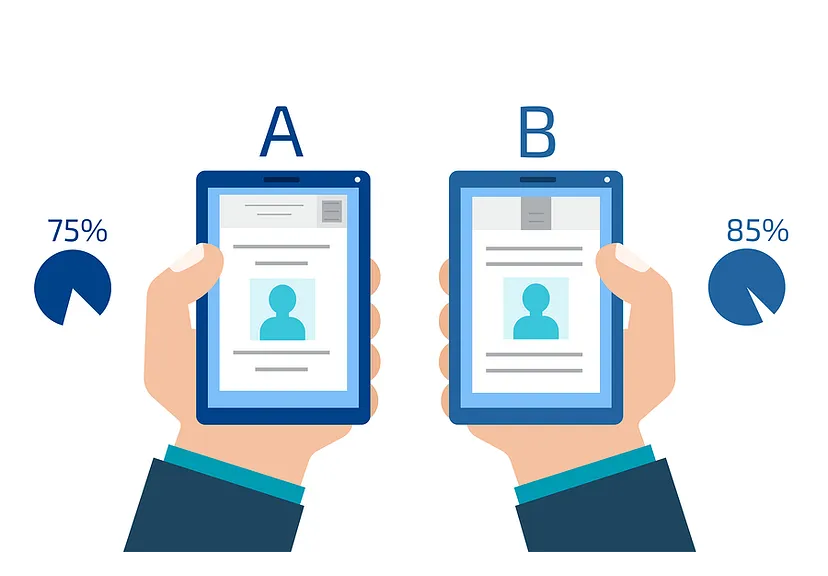
This could involve varying the messaging, offers, or timing based on the user’s behavior or stage in the customer journey. Segmenting your audience in this way allows for more relevant and targeted popups, improving user engagement and conversion rates by delivering content that speaks directly to the user’s needs and interests.
Also Read: 9 Simple A/B Tests You Should Perform for Higher Conversions
Implementing A/B Tests for Popups
Conducting A/B tests for popups is quite simple. All you need is a popup builder tool with built-in A/B testing that can help you conduct A/B tests all under one roof. We’ll take Picreel as our tool of choice because it excels in popup creation and A/B testing altogether. Let’s take a look at the steps:
Step 1 – Navigate to the “A/B Testing” option on the left side of your Picreel dashboard. This section allows you to manage and create A/B tests.
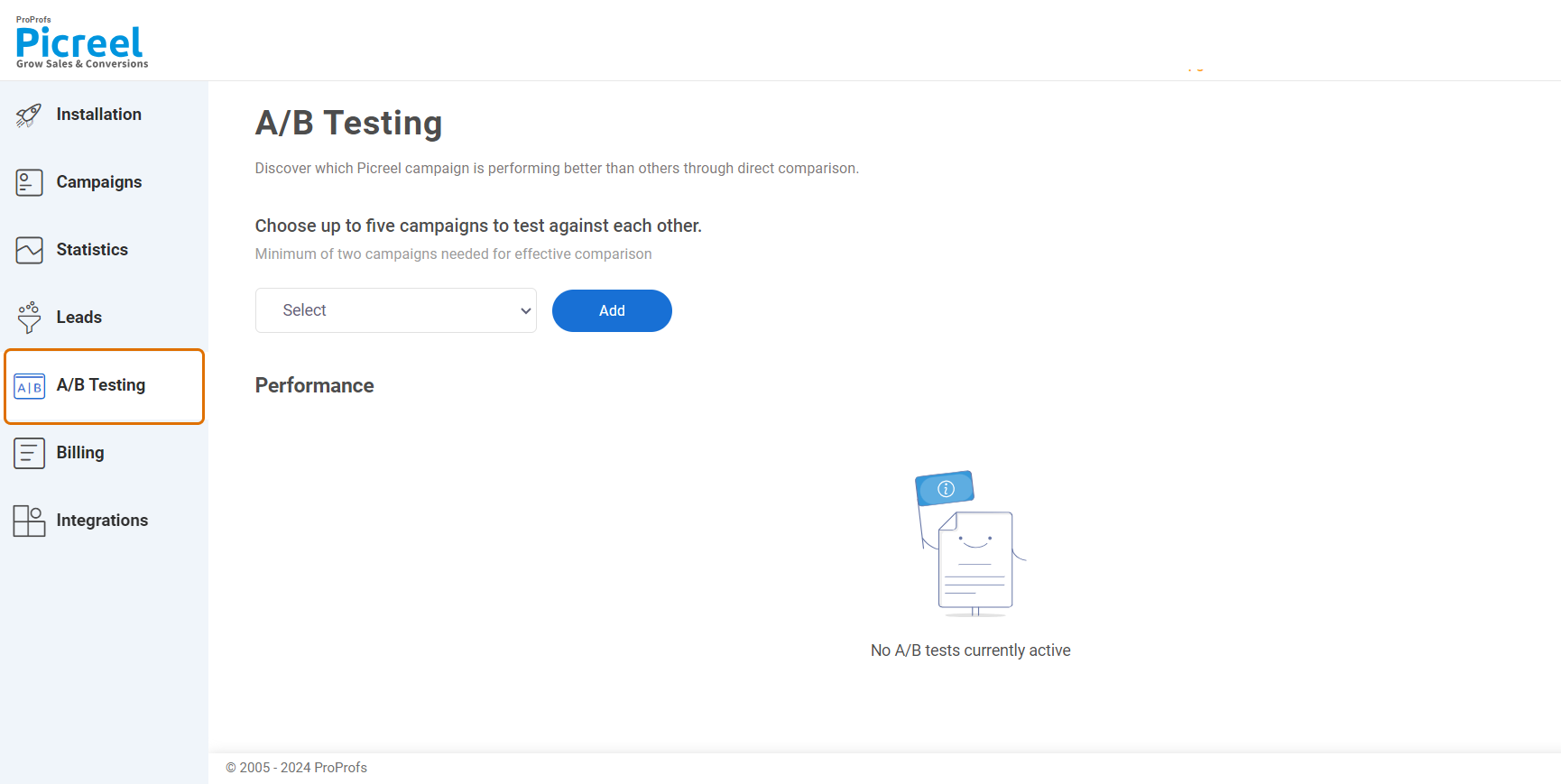
Step 2 – Use the dropdown list to view and choose the campaigns you want to test against each other. Click the ‘Add’ button to include your selected campaigns in the A/B test. Remember, you must choose at least 2 campaigns and can select up to a maximum of 5 for each test.
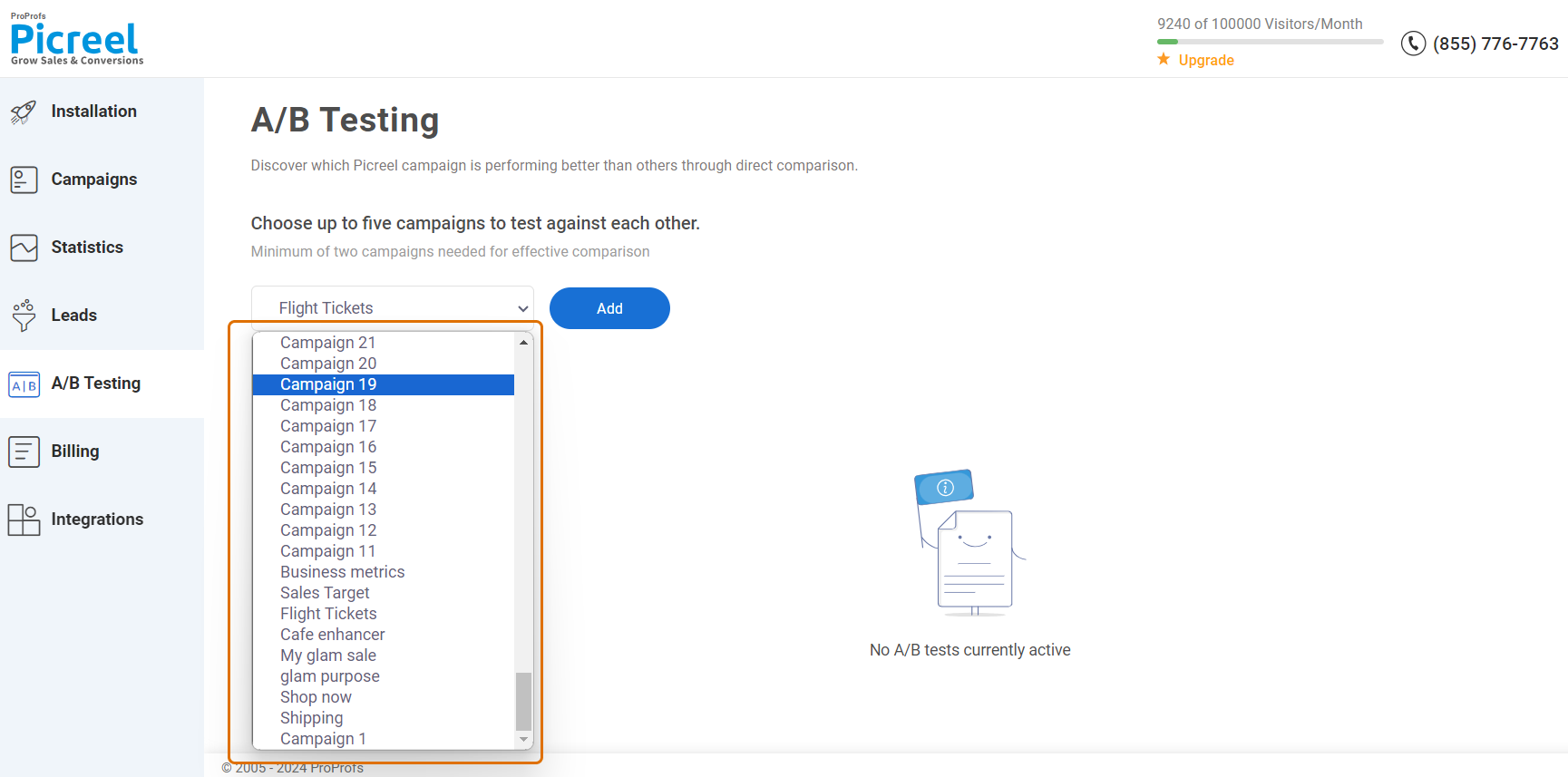
Step 3 – To understand how individual campaigns are performing within your A/B test, click on the report icon next to each campaign’s name. This will provide detailed insights into each campaign’s effectiveness.
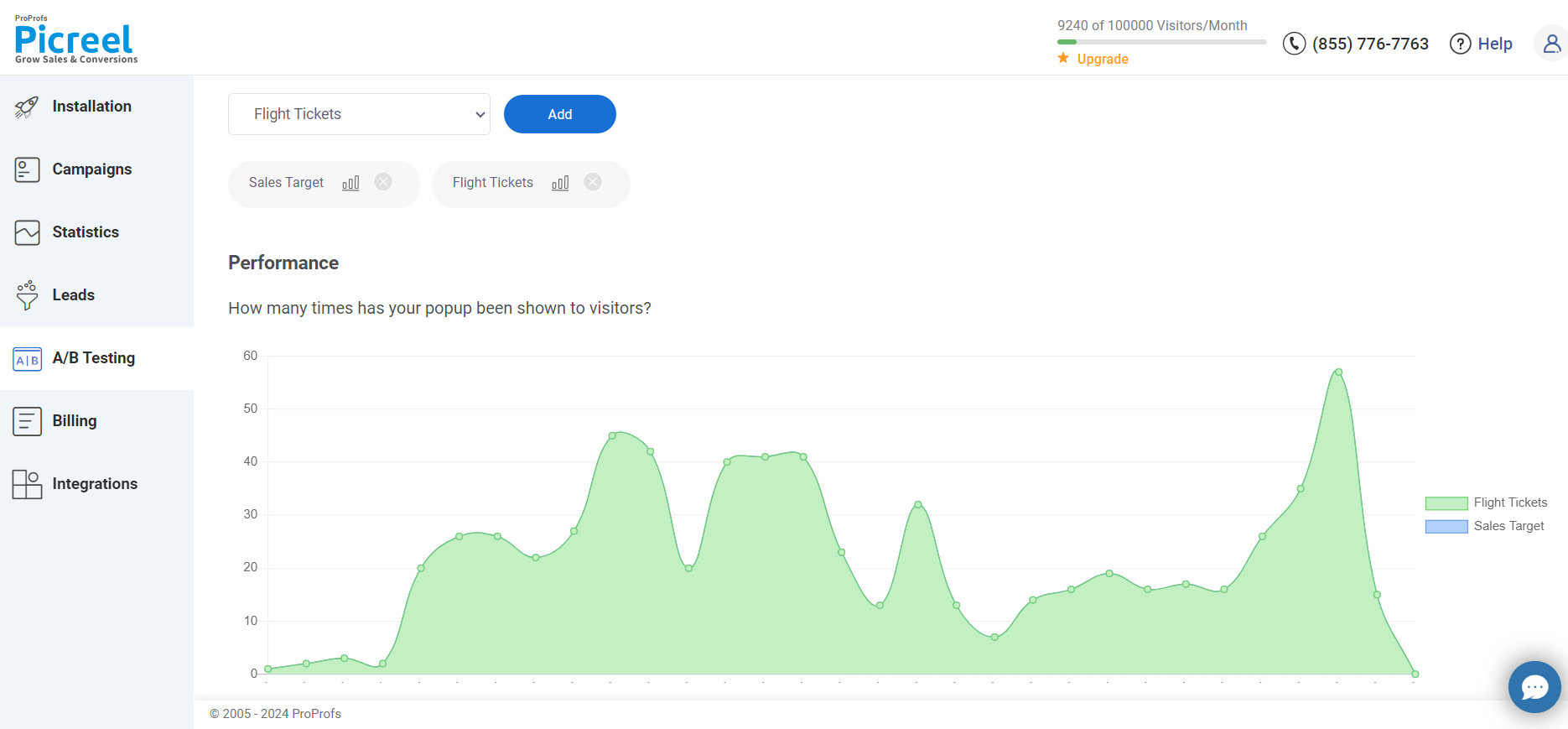
For optimal results, keep in mind that the duration of your A/B test should be adjusted based on your site’s traffic—higher-traffic sites may yield quicker results. Additionally, if you plan to conduct tests frequently, setting a time limit for each test can help maintain efficiency and effectiveness.
A/B Testing Optimization and Best Practices
To elevate the effectiveness of your A/B testing strategy and enhance overall website performance, adopting a series of optimization practices and adhering to core principles is essential. Here’s a deeper dive into some pivotal strategies:
Iterative Testing
Iterative testing embodies the philosophy of continuous improvement in the realm of A/B testing. This approach entails a cycle of creating hypotheses, conducting tests, analyzing results, and applying learnings to the next set of experiments.
By perpetually refining and iterating based on previous outcomes, you ensure ongoing enhancements to your website’s design, functionality, and content, ultimately leading to sustained uplifts in performance metrics.
Clear Objectives
The clarity of objectives cannot be overstated. For every A/B test, having a well-defined goal—be it improving engagement metrics like click-through rates or conversion goals such as increased sign-ups—is crucial.
This focus not only guides the design of your tests but also simplifies the analysis of outcomes, enabling precise measurement of success and clearer insights into user behavior and preferences.
Segment Your Audience
Audience segmentation is the cornerstone of effective A/B testing. Recognizing that different user segments may react distinctively to the same experiment, it’s critical to categorize your audience based on demographics, behaviors, or traffic sources.
Such segmentation allows for more personalized testing and more granular insights, paving the way for tailored experiences that resonate deeply with each segment, thereby elevating engagement and conversion rates.
Minimalist Design
A minimalist design philosophy advocates for simplicity and clarity in the elements being tested. By stripping away non-essential elements and focusing on key components, you reduce cognitive load for users, making it easier for them to comprehend and act on your call to action.
This not only enhances user experience but also ensures the changes being tested are directly attributable to variations in user behavior, thereby delivering more accurate and actionable insights.
Fast Loading
In A/B testing, the speed at which your pages and elements load is critical. Slow loading times can distort test results and negatively impact user experience, potentially leading to increased bounce rates and skewed data.
Ensuring both the control and variant versions of your test load swiftly is crucial for maintaining the integrity of your test and providing a seamless experience for all users.
Mobile Optimization
Given the predominance of mobile browsing today, optimizing your A/B tests for mobile users is paramount.
This entails not only ensuring responsive designs but also considering the unique context and constraints of mobile usage. Mobile optimization guarantees that your testing efforts are comprehensive and reflective of the entire user base’s experience, thereby maximizing the efficacy of your tests across all platforms.
Data-Driven Decisions
The essence of A/B testing lies in making informed, data-driven decisions. Leveraging the quantitative insights gathered from your tests allows you to base your optimization strategies on solid evidence rather than intuition.
This analytical approach ensures that the improvements you implement are validated by real user data, leading to enhancements that genuinely resonate with your audience and drive better outcomes.
Also Read: 11 Popup Best Practices to Drive Conversions
FREE. All Features. FOREVER!
Try our Forever FREE account with all premium features!
Easily A/B Test Your Popups for Maximum Impact
Effective A/B testing transcends mere experimentation, embodying an iterative, data-driven journey toward optimization.
It necessitates distinct objectives, nuanced audience segmentation, and an unwavering commitment to user experience, underscored by minimalist design, swift loading, and comprehensive mobile optimization. By rigorously adhering to these best practices, businesses are empowered to make informed, impactful decisions.
This approach not only elevates website performance and user satisfaction but also paves the way for substantial increases in conversion rates, marking the path towar
 Tips
Tips
We’d love to hear your tips & suggestions on this article!
FREE. All Features. FOREVER!
Try our Forever FREE account with all premium features!

 We'd love your feedback!
We'd love your feedback! Thanks for your feedback!
Thanks for your feedback!







